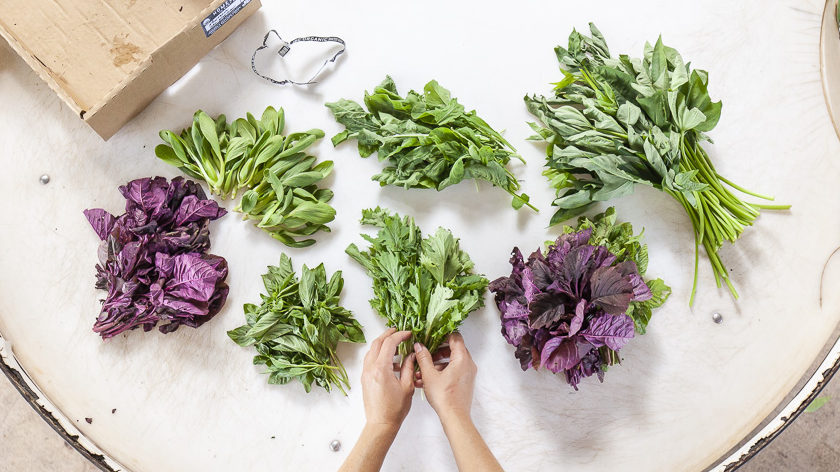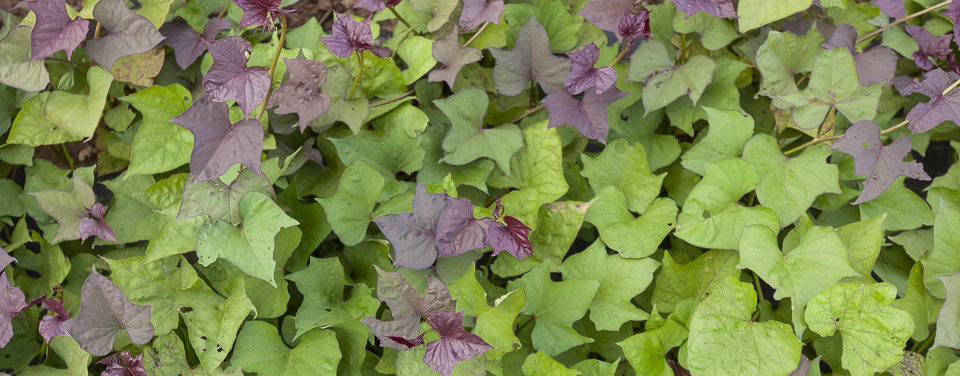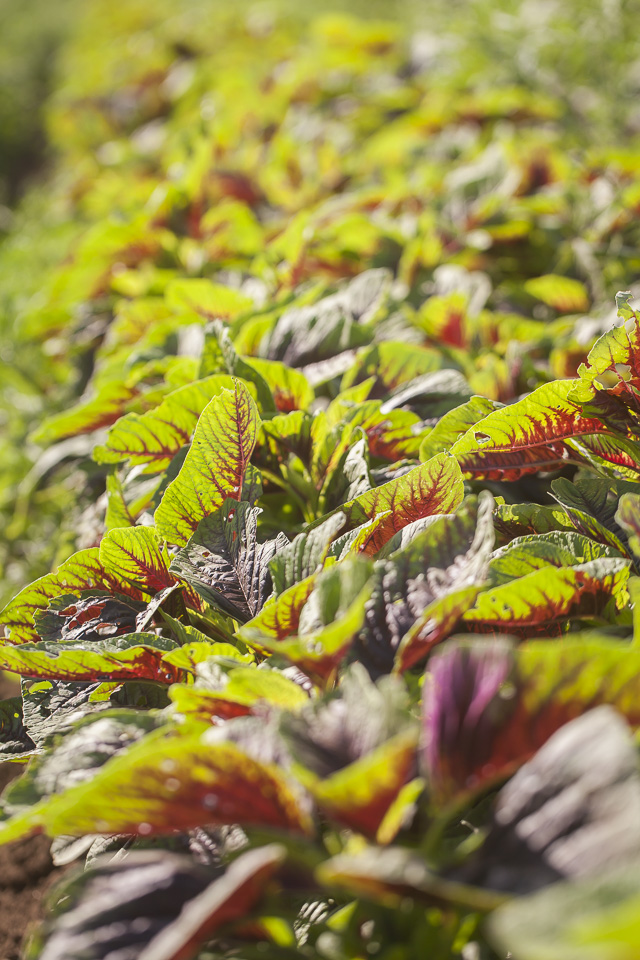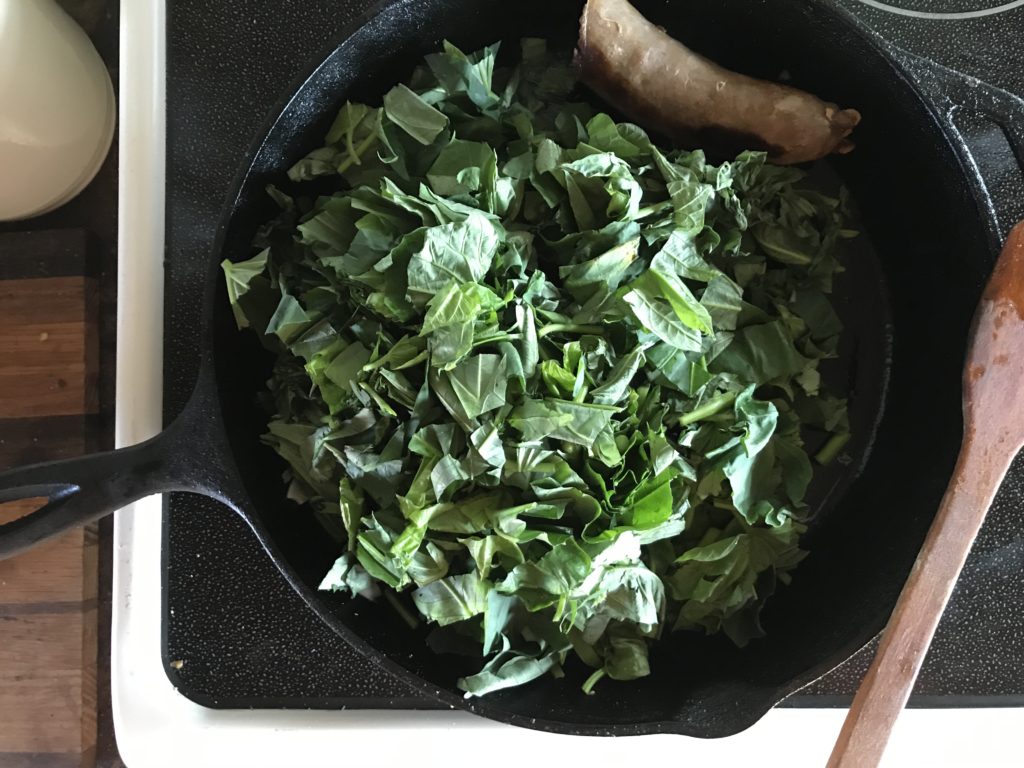
THE GREENS OF SUMMER
07/30/21 — Ada Broussard
 Behold: The Summer Greens. Photo by Scott Gordon
The greens that we usually associate with a healthy diet (kale and collards) are out of season during the hot Texas summers. They’re about as distant of a memory as sweatshirts. The kale in most grocery stores right now is being shipped from faraway farms and the high summer sun is no place for green leaves… or is it?
We got to thinking, or rather, looking around the farm… there is, in fact, plenty of green to go around! The greens we’re growing this summer are especially well-suited to grow in warm… err… scorching weather, and this means they may be greens you’re accustomed to seeing. In fact, many of you have called and asked what the star-shaped leaf in your CSA box is (sweet potato greens), or what to do with the small but dense bunch of amaranath that you picked up at market. Today on the Daily Dirt, we’re here to introduce to The Greens of Summer. Your best leafy friends, harvested in the early morning hours before the sunshine has gained her strength, here to add some verdency to the usual pallet of red peppers and purple eggplant.
Behold: The Summer Greens. Photo by Scott Gordon
The greens that we usually associate with a healthy diet (kale and collards) are out of season during the hot Texas summers. They’re about as distant of a memory as sweatshirts. The kale in most grocery stores right now is being shipped from faraway farms and the high summer sun is no place for green leaves… or is it?
We got to thinking, or rather, looking around the farm… there is, in fact, plenty of green to go around! The greens we’re growing this summer are especially well-suited to grow in warm… err… scorching weather, and this means they may be greens you’re accustomed to seeing. In fact, many of you have called and asked what the star-shaped leaf in your CSA box is (sweet potato greens), or what to do with the small but dense bunch of amaranath that you picked up at market. Today on the Daily Dirt, we’re here to introduce to The Greens of Summer. Your best leafy friends, harvested in the early morning hours before the sunshine has gained her strength, here to add some verdency to the usual pallet of red peppers and purple eggplant.
 Lush greenery... with some pops of purple. Photo by Scott David Gordon.
A note on the recipes list below: Guess what? Any of the greens you find in your CSA box this summer (and winter, for that matter) will work with just about any of these recipes. If you’re interested in experimenting in Caribbean flavors, chop your greens and head to the callaloo recipe mentioned under amaranth. Needing some soy sauce in your life? Use any summer green, and make the simple Chinese stir fry mentioned under bok choy. Just make sure to eat your greens. But first, let's meet your greens.
Lush greenery... with some pops of purple. Photo by Scott David Gordon.
A note on the recipes list below: Guess what? Any of the greens you find in your CSA box this summer (and winter, for that matter) will work with just about any of these recipes. If you’re interested in experimenting in Caribbean flavors, chop your greens and head to the callaloo recipe mentioned under amaranth. Needing some soy sauce in your life? Use any summer green, and make the simple Chinese stir fry mentioned under bok choy. Just make sure to eat your greens. But first, let's meet your greens.
GREEN (and purple): Amaranth
ORIGIN & NUTRITION: You may be familiar with amaranth in its grain-form (a superfood of its own), but we’re here to talk-leaves. Amaranth is indiginous to South America, and not surprisingly, the Aztecs cultivated the plant, and consumed both the grain and leaf form. Because of the plant’s hardiness, amaranth's popularity spread and it has a long culinary history across the globe, used in cuisines in South America, Africa, Asia, and the Carribean (where it’s referred to as “callaloo”). What do these regions and Texas have in common? Well, the unrelenting summertime heat, of course. Amaranth was born to stand up to the heat, and in fact the name comes from the Greek amarantos meaning “one that does not wither,” or “the never-fading”. Amaranth is dense in nutrients: it contains tocotrienols, a special type of vitamin E good for brain and body function, as well as vitamin C, calcium, carotenes,, magnesium, potassium, as well as a good helping of iron. LIKES: Amaranth likes being transformed into a West Africian/Carribean Callaloo Soup, or if you’re feeling particularly adventurous (and in the mood to track down a couple of unusual ingredients) make Efo Riro - a traditional Nigerian stew featuring this green. Amaranth enjoys taking the place of spinach in the North Indian preparation of Chaulai Ka Saag. When in doubt, use amaranth in any recipe calling for spinach. Both the green and purple varieties will work beautifully. WHY WE LOVE IT: If there was one superhero of the group, it would be amaranth. It’s probably the most nutritionally dense, and is also the most well-traveled green of the group. If you need recipe inspiration for this green, you can go to just about any continent and find something tasty. We love the vigor and versatility of this plant - it often crops up (ha) as a weed in gardens, and every part of the plant from root to stem to leaf to seed is edible. Don’t be alarmed by some of the tiny holes you might find in amaranth greens. These are purely cosmetic, and should be a reminder that you’re eating organic produce - void of any pesticides or insecticides. Amaranth in the fields. Photo by Scott David Gordon.
Amaranth in the fields. Photo by Scott David Gordon.
GREEN: Sweet Potato Greens
ORIGIN & NUTRITION: Sweet potatoes are indigenous to Central America, and along with other crops like white potatoes, corn, tomatoes, amaranth (!) and tobacco, sweet potatoes made their way to Europe via the Colombian exchange. They are rich in vitamin B, ßcarotene, iron, calcium, zinc and protein. Even NASA took notice of sweet potato greens’ nutritional value - it’s one of the crops they selected to be grown in a life support system - aka the environments designed to keep humans living and working in space alive. But you don’t need to leave earth’s atmosphere to enjoy these greens... LIKES: Sweet potato greens like any recipe that calls for spinach. We think sweet potato greens are the closest substitute to spinach, though it’s noteworthy that they lack oxalic acid--the substance in spinach that sometimes leaves an astringent feeling in your mouth; one point, sweet potato greens. Sub sweet potato greens in your quiche lorraines or classically Louisiana spinach madeleine. Please, simmer sweet potato greens in coconut milk to spoon over rice, or add variance to a simple stir fry with this Malasian version which adds belecan, or shrimp paste, as well as hot chilies to the wilted green. WHY WE LOVE IT: At JBG, we love the industrious nature of this green: While sweet potatoes dutifully grow underground getting ready for an early fall harvest, their tops soak in the sun and provide food for the summer. Two crops, in one! Plus, sweet potato greens are highly pest resistant, and we can often get multiple cuttings of sweet potato greens from any given bed. Last, we love sweet potato greens because they feel so southern - the perfect green to replace collards in a slow cooked, ham-hocky preparation. When cooked, sweet potato greens are tender and silky, practically melting in your mouth. You're welcome. Sweet potato greens in the skillet. Photo courtesy of Club Home Made.
Sweet potato greens in the skillet. Photo courtesy of Club Home Made.
GREEN: Mizuna
ORIGIN: Mizuna, sometimes called Japanese lettuce, hails from… you guessed it, Japan. LIKES: Mizuna likes any recipe that shows off its delicate peppery flavor - including both raw and cooked preparations. It’s a traditional ingredient in Sukiyaki, or Japanese hot pot, and would also make a wonderful sub for spinach in this Japanese ohitashi (sauteed greens in broth). To truly appreciate this green, try it fresh in a simple salad, like this one with lemon juice, radishes, and sunflower seeds. We think the peppery flavor would even stand up nicely to a thin Cesar dressing, perhaps skipping on the bulky croutons and instead adding crunch with something smaller, like toasted breadcrumbs or bacon bits, if you dare. WHY WE LOVE IT: We love the introduction to Asian flavors that Mizuna begs. Though it’s gaining popularity in some home kitchens, it’s still somewhat of a specialty crop and we relish in the opportunity to give our CSA Members and market customers the interesting ingredients that are normally reserved for fancy chefs. Our mizuna seeds come from Kitazawa, a very unique and specialty seed company founded in 1917 by Japanese Americans who longed for the vegetables of their homeland. Kitazawa is one of the oldest, if not the oldest, seed company in the United States, and their offerings of heirloom Japanese vegetable varieties is unparalleled. We’ve worked with Kitazawa for many years, and can’t help but think of this seed company's lovely history and their awesome seed reps when growing this crop.GREEN: Baby Bok Choy
ORIGIN AND NUTRITION: As the name implies, this is the baby version of grown up bok choy, or pak choy, or Chinese cabbage, or spoon cabbage. This baby belongs to the brassica family, and so it is, in fact, related to cabbage. This green, which is a brand new summer offering here at JBG, is indigenous to China and has been eaten for thousands of years---archaeologists found bok choy seeds dating back to 6,000 years ago. Compared to some of the other greens on this list, bok choy isn’t as impressive of a nutritional powerhouse, though the vegetable still does contain loads of vitamins A and C. LIKES: Two words, one technique: stir fry. Baby bok choy should be the star ingredient in any Asian stir fry, thrown in a hot pan for a quick flash until the tops are just wilted and the bottoms tender, but still with some structure. We love traditional and simple Chinese flavors with our bok choy, like this quick saute recipe. Bok choy would also be a wonderful addition to any soup, and a quick google search for “bok choy soup” will lead you to an arsenal of recipes featuring bok choy with other ingredients like garlic, ginger, lime, and mushrooms. You could even practice your fermentation skills and make kimchi with this baby bok choy, though honestly we suggest you wait till the bigger stuff starts to roll in and just enjoy these tender little treats with the simplest of preparations. Dare we even say, raw! WHY WE LOVE IT: Texture! One article we read warned readers not to confuse this vegetable with celery, and while we’d like to think our readers aren’t that vegetable-naive, it begs a good point: the stem of this veggie (in both baby and adult form) is deliciously crunchy, and actually not a bad substitution for celery. We are especially in love with JBG’s current crop of baby bok choy because of its small size and oh-so-tender flavors. Baby bok choy are just a joy to eat whole, or perhaps sliced in half (longways) to show off their shape. Think of these baby bok choy as tiny trees, just like broccoli florets, begged to be kept whole, maybe even requiring a knife at dinner time. We harvest these little babies tiny, before they have time to realize the hot world they’re sprouting into, and we hope you enjoy this small baby green as much as we do.GREEN: Arugula and Basil.
If you’ve never met these summer greens, you must be living under a rock. We don’t mean to diminish the excellence of these summer offerings, but this post is getting long and we think you know these greens well: bright arugula salads with goat cheese and toasted nuts. Simple summer pastas with torn basil or grilled bread smeared with fresh pesto. Both America and Italy honor these greens well, and we know you know how to make them shine (hint: olive oil).GREEN: Purslane
To read plenty on purslane, checkout the Daily Dirt post from a couple weeks ago. It was this summertime green that inspired today’s post.. .we wanted to you to meet the rest of the summer greens gang! Well, here the are! Now that you know them, don’t forget to eat them! Before you know it, we’ll be wallowing in kale and swimming in collards and the unique flavors of our summer greens will be a distant memory. If you have any favorite preparations of these greens, shoot us a line and let us know! Happy cooking! Arugula harvest. Summer greens are harvested first thing in the morning before the day really heats up. Photo by Scott David Gordon.
Arugula harvest. Summer greens are harvested first thing in the morning before the day really heats up. Photo by Scott David Gordon.





 0 ITEMS IN CART
0 ITEMS IN CART 

